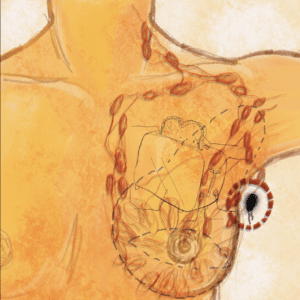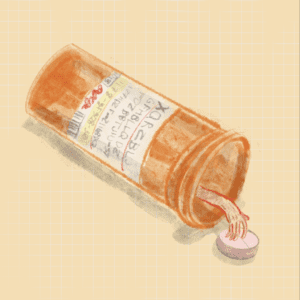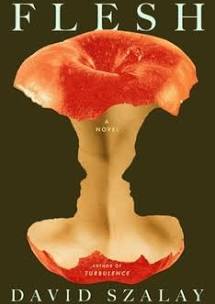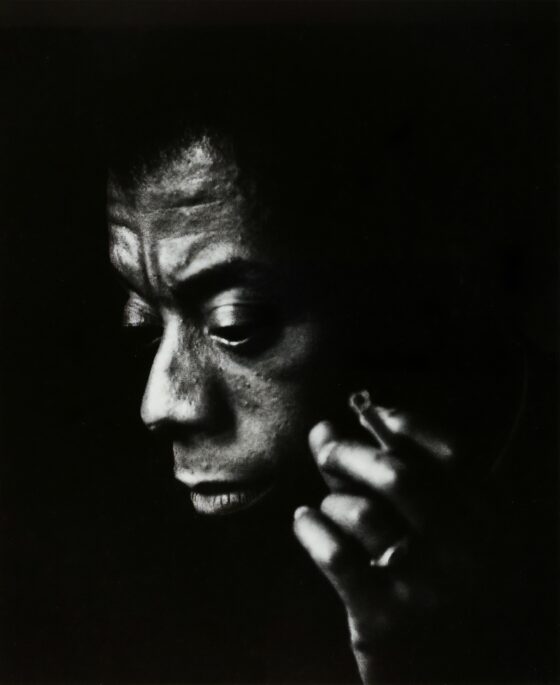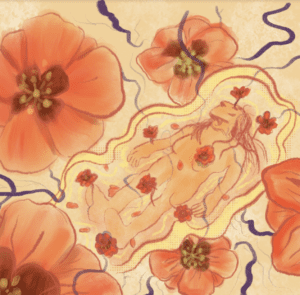
In the two years that I have been continuously sober, free from drink and drug, I have had four major operations. Each operation came with a recovery, and each recovery came with an opioid prescription.
***
I have always liked opioids, charmed by their neat little near-controlled freefall. My first whirl into that world was with a Vicodin prescription after I tore the meniscus in my right knee during my final year of high school. The meniscus is the little piece of cartilage that keeps the leg bones from rubbing against each other, like a rubber gasket. The tear was just about a centimeter, curled up like a piece of painters tape right off the roll, according to the surgeon. They prescribed me forty pills, but I only needed a few a day for a few days before the pain subsided. My mother kept the bottle in her underwear drawer, probably already wary of my propensity to misuse them.
My memory for a lot of my life is fuzzy, and it is difficult for me to recall feelings, thoughts, motives during my high school years. My life at that time felt cast in the shadow of an ever-larger encompassing storm of inscrutable emotional pain, any semblance of agency smothered beneath a strict schedule of school, sports, and attacks on my sartorial choices, and the mental relief I experienced during my prescribed use made me seek out that little orange pill bottle for some extra time with the drug. I remember taking three pills one afternoon and lying halfway off my bed, staring at the ceiling, blissed the fuck out for a couple hours. It took me away, out of my body, and that was exactly where I wanted to be. Anywhere else but where I was. Paradoxically, by deliberately releasing my grasp on reality I felt more in control than I ever had been.
I got sober just shy of my twenty-ninth birthday. Two months later, I was diagnosed with breast cancer. It was pretty surprising, considering I was under the age of thirty, and a trans woman. Lots of people will try to argue that men get breast cancer too, but it’s not common, especially not for someone like me. I tried to find those cases of young “males” with breast cancer diagnoses and there were four. Four cases. And anyways, my cancer happened the way it happens to breast tissue in women—the mammary glands developed within the distinguishing female hormonal levels, my breasts small but grown—making the whole discussion a moot point.
It was in situ, which means that it was still contained, had not spread, and was given a stage 0 designation. It was cancer, but it was like an unhatched egg, all of its goo not yet oozed into the cracks and crevices of my breast tissue. My doctor proposed several treatment plans, all with extremely optimistic outcomes.
I opted for a bilateral mastectomy, and then reconstruction with silicone implants five months later. Two major operations with a torturous tissue-expansion process in between. It was the most drastic treatment option, but breast cancer runs in my family, and I did not want to continue to deal with the worry and maintenance for the rest of my life, ultimately needing a mastectomy down the line anyway. Plus, I could upgrade to a large C-cup from my modest A-cup, with everything paid for by Medicaid.
Bilateral mastectomies are pretty hefty surgeries. Not only do they carve out all your breast tissue, but they take a margin around it, just to be safe, including pieces of your chest muscle. They also take out lymph nodes to make sure that no carcinoma cells have migrated. In my armpit, or just below, they made an incision and took out three of the five that I had there. One or two of the lymph nodes looked like they had been dyed black. I have a tattoo of the schematic of a toaster on the right side of my chest, the fourth tattoo of many more that would follow. It’s unclear whether Jack, the tweaker artist at the shop below the J train on Broadway, directly injected ink into the lymph node while going over my skin, or my body had processed it and given the lymph nodes some color, the way celery will turn red over time if you put it in water with a little bit of food dye, but my doctors were amused either way.
In the weeks leading up to my mastectomy, I spoke extensively to my A.A. sponsor about the painkillers I knew my doctors would prescribe me. I was finally serious about getting sober, and remaining so, despite the countless breaks I had taken over the years. My first break from alcohol was at the age of seventeen after I got almost-arrested for walking into a stranger’s house at one in the morning, twelve-pack of Natural Light beer in hand, excused for the privilege of being a white kid who lived in town whose dad came to retrieve them from the three cop cars at the scene instead of going to the police station; many other breaks from drinking followed many other incidents. I was petrified that I would have to choose between excruciating post-op pain or compromising my sobriety.
One of the rules in the meetings where I got sober is that medication is to be used as prescribed. However, a lot of people have a lot of ideas about what is really okay, and as a newcomer in a program with a bunch of rules that are mere suggestions but maybe are actually rules, none of which did I yet understand, it was difficult to parse through what was legitimate concern for my well-being and what was some old-timer’s unshakable opinion. My sponsor and I arrived at a good place, agreeing that as long as I was aware of how I was using the drugs, using them for pain and nothing more, then it should be okay. We also agreed it might be a good idea to let my girlfriend keep track of the pills as another layer of security. I wanted to stay sober, but I am also an addict, who has the tendencies of an addict, one of which is always trying to do drugs. In order to not drift off the rails, I had to let go of the reins. Over the years, my understanding of letting go had taken a more destructive flavor—based on my history, I wouldn’t trust me, despite my most pure intentions.
The first week or so passed with no concern around the Percocet. I used it as prescribed, one pill every four hours, and the pain was incessant enough that there was little doubt that my use was appropriate. Near the seventh or eighth day, I started to really notice a hazy, loopy feeling take hold of me whenever I swallowed a pill. This feeling was familiar, and was what I had been so scared of falling prey to—that enrapturing embrace, so warm and so gone. This gray area, where the pain was still substantial, but the drugs were having cognitive, moody effects, caused me a crisis.
Scared to break my sobriety, I refrained from a dose one afternoon, hoping I could move onto non-narcotic pain relief. An hour and a half in, the pain mounted, and I panicked. I called a friend in the program, and I cried—my chest hurt so bad, it was painful to sit up, but I wanted to stay sober, and I didn’t know what to do, and I was so overwhelmed, and I hated that I had to make these decisions, hated that I wasn’t normal, because I just wanted to heal, from the surgery, from the trauma, from a life that was ravaged by the depths of alcohol and drug abuse, and I cried harder and louder, the phone in front of my face, as my friend patiently listened. I ended up taking a pill. If I was so torn up about popping a single pill while my body screamed in pain, it felt safe to say that I was not trying to scam the system, to get a quick fix under the cover of the surgery.
It can be so easy to ascribe the worst intentions to yourself, especially when you are in the middle of sifting through the worst parts of yourself, the grueling stage of sobriety in which I was engaged. Essential to this stage is allowing some grace and compassion, but this can lead to overcorrection. Oscillating between being absolutely unforgiving and unduly lenient towards myself, I needed an outside source to corroborate reality, and I was fortunate to have a friend in that moment. After that afternoon, I continued to heal, free from any more crises.
Most of my post-tween life had been plagued by a predictable pattern of destructive, defiant behavior accompanied by the tired chorus of my family and friends begging me to stop. There were small interruptions, but the cycle continued. However, once I stopped inundating my system with copious amounts of alcohol, seizing up my ability to make sound judgment, I discovered that I was able to grow and develop from my experiences, making informed decisions that signaled some kind of forward progress. Using opioids while maintaining my sobriety became a skill that I continued to develop over the following couple of years. The irony—finally becoming capable of moderating my drug use—was not lost on me.
My next trial was my breast reconstruction five months after my mastectomy. Accepting my surgical future, the thrifty part of me tuned in to capitalize on my O.R. time. To spice things up, I arranged for a urologist to join us in the operating room to perform an orchiectomy, a procedure where they make a slit down the center of the scrotum, pop the testicles out, and sew you back up. I figured if I was healing from one thing, I might as well double down and knock another thing off the list.
The recovery from this surgery was remarkably unremarkable. I remember a discrete dose of the pain meds—I think they were Oxycodones this time—about a week post-op when I felt a distinct drop in my ability to focus and be present, impaired as opposed to just medicated. I only took one more dose after that, confident, maybe to the point of complacency, in my medication management. It felt good to take narcotics the way normal people take them. It felt good to be a good sober person.
A common admonition in my sobriety program is to be wary of resting on your laurels. Achieving two years of sobriety does not guarantee you two more, just like constant training for one marathon does not promise the same performance a year forward with no continuing work in between. In the six months leading up to my next surgery, I bolstered my sobriety, pushing into the program that had gotten me to this point, faithful that it would carry me through again.
Facial-feminization surgery is a catchall term for an infinite combination of plastic surgery procedures to give the face features that read more feminine. Some girls get their nose done, some opt for a lip lift, some have their forehead broken, shaved down, and then pieced back together, and some get the double double with everything, a list of procedures fifteen lines long. Everyone starts with a different baseline, and everyone desires different results. Oh, and some girls have money and some girls do not. Through some continuation of my divine good fortune with Medicaid, I was able to get my rhinoplasty, brow reduction, and eyebrow lift completely covered with not a single cent from my pocket. I did not question my bureaucratic blessings then, and I will not question them now.
This procedure was more involved than it seems, mostly considering the part where my surgeon made a coronal incision, at the crown of my head, and peeled my face off of my skull to perform the work she was there to do. It sounds medieval to me, totally gruesome. To my surprise, this procedure was outpatient, and, face wrapped up and swollen shut, they sent me home the same day.
They shoved my pants on, put me in a wheelchair, and rolled me out the door, directly to the passenger seat of my girlfriend’s Honda CR-V. Within an hour or two of being home, I was in my bed, oscillating between sitting up in high alert and collapsing dramatically into a pile of pillows every other minute. My head was spinning, and I felt very ill. The only words I could muster were “I don’t like this,” over and over and over again.
My girlfriend called the number they had provided on my discharge sheet, and as she was explaining my current situation to the nurse, I began to projectile vomit dark brown liquid, filling the bottom half of a small metal trashcan.
“Now she’s vomiting what looks like a lot of blood,” I heard my girlfriend say from the hallway. Turns out the little thing they stuck behind my ear to help with the nausea from the anesthesia did not help with the nausea from the anesthesia. I did feel eons better after all the blood vomiting, though, which reminded me of the classic boot-and-rally trick from my drinking days. Sometimes you just have to stick a couple of fingers down your throat, clear the stomach out, and you’ll be back on the up in no time.
They gave me a very limited amount of Oxycodones, less than a week’s worth, which made the management of their use feel effortless. The one trick I did employ, to give myself some semblance of control, was to leave a single pill in the bottle. That one lone pill proved that I, myself, had made the decision to stop using the medication, removing any and all doubt that my use had been anything but as prescribed. It was true—I had only used the opioids for the pain, and not to get high—but this behavior of signaling that I was Good and Responsible felt alarmingly similar to the hollow ways in which I used to try to convince the concerned chorus of loved ones in my life that I was finally getting better, that my alcohol and drug use was going to be different this time.
I became so good in my addiction at feigning sincerity, to the point that even I believed myself despite my constantly unchanging behavior, that when I began to actually do things in sobriety to address my missteps and change my behavior, I felt waves of doubt overtake me. My actual efforts to right the wrongs of my life felt so similar to the performances in my addiction, that it became a struggle to convince myself that this time really was different. And somehow, in my brain, the gesture of leaving a single pill in the bottle took on that familiar color of deception, even though its meaning was known only to myself. The one thing I could rely on was my actions; regardless of whatever symbolic game I was elaborating in my head, I did not misuse the drugs, and that would not be changed by the emotional mess I still had to sort through.
I used to fantasize about morphine. I remember someone proudly telling me about their grandfather, who, amidst an agonizing death, refused morphine. It was something about courage or bravery or some other posturing nonsense. First off, I think this kind of boasting is misguided, at best; self-imposed suffering is not admirable, and its claim falsely casts anyone who does opt for pain relief as a coward. Second, all I could think of was how delicious it would be to have a button that would immediately deliver me into sedation. I imagined a warm, viscous bath, the same secure feeling I had with my first full dose of nitrous oxide at the dentist. Floating on air in a polarized pulsating coffin, a dull quiet hum, suspended in the buzzing embrace.
I did not anticipate my first encounter with morphine would be during my second year of sobriety. The sounds of my former self weeping at this misfortune rattled in my head.
Out of all of my surgeries so far—the torn meniscus that inaugurated my opioid habit, a reconstructed ACL four years after that, the breast cancer ordeal, and my plastic surgery face-peeling—the most intensive and involved has been my vaginoplasty. To be brief, a team of reconstructive urologists dug a hole into my pelvic floor, and then after field dressing my genitalia like a freshly killed deer, taking all the inside bits out, they did a bit of patchwork with the hide, fashioned it into a “skin tube” (the official term used on the diagram provided to me in my prep packet), and shoved it on into the newly cavernous canal. It took about eight hours to complete the surgery, and I awoke to an empty room, completely devoid of visitors thanks to COVID-19 restrictions. There were tubes coming out of my crotch, and another set of tubes connected to two IVs in my left hand. One of them led to a machine with a little digital readout, and coming out of that, onto my bed, snug against my body, was a little remote control with a single button.
There was a lock-out function programmed into the drip machine, most likely to prevent patients from introducing lethal amounts of morphine into their system, but when they told me that I could only press the button once every ten minutes, my first thought was relief, that I wouldn’t be able to abuse it if I tried. But even with built-in moderation, assured that six doses an hour is absolutely as prescribed, I could not help but feel like an addict. I kept track of the clock, watched the display panel every few minutes, waiting for the panel to change from LOCKOUT to AVAILABLE so I could click as soon as I was allowed to. It felt the way I treated every drug I had ever done, constantly keeping track of the bottle, or cup, or pack, or straw, or baggie, or, or, or… Always needing more, no matter how much I had already had, my mind constantly calculating how much was left and where it was, and where to go once what was left ran out. My favorite state to achieve was total obliteration, with enough supplies to get me there twice over again within an arm’s reach.
I know that place well, total obliteration; I spent most of my time trying to get there, and as much time as I could staying there. The access to the morphine, and its seeming endless supply, scared me. After a day, I attempted twenty minutes without a click. It is a thankless effort trying to find the line between tolerable pain and morphine-worthy pain. I never felt proud that I had withstood an extra four minutes between doses, and the only noticeable result was a bit more pain for a little while longer. After several attempts to show myself that I could go without the drip, I returned to my ten-minute tracking, comfortable in knowing I had nothing to prove.
Eventually, my high-pony-tailed RN unplugged me from the morphine, and it became my responsibility to ask for and remind my team of nurses of my Oxycodone every four hours. Again, if I waited an extra hour, the pain began to mount, and it took more time to get the pain back down to where it would have been had I simply stuck to schedule. And as someone who has spent my entire life trying to score as many free drugs as possible, the mental fortitude needed to be honest with myself, to stave off the feelings of residual guilt, to accept my need for pain relief was a real fucking challenge.
My last big dose of the Oxy’s was right before my discharge from the hospital in preparation for a bumpy (oh, beautiful Philadelphia roads) hour-and-a-half ride to our house in the country. Once home, I really did use the opioids as needed. I finished the bottle, barely enough for a week’s worth, never unsure of how appropriate my use was for more than a few moments, no longer needing to leave that one single pill as a symbolic beacon of my unshakable sobriety. I had harbored a healthy dose of fear, just enough to keep me vigilant. I need that—too deep in my comfort, and I will falter.
***
Rumpus original art by Eli Brandwein

